Watercolor Coffee Painting (A Complete Step by Step Tutorial)

I’ve heard it said that coffee boosts creativity. Whether that’s true or not, I thought you might like to join me by following along with this watercolor coffee cup tutorial.
I’m always on the lookout for new subjects to paint. The ring stain of coffee on my desktop provided the inspiration for this latest watercolor. I was sipping my coffee this morning and putting the cup on a sheet of paper. This left a circular mark each time I put down the cup.
Messy me…
And this watercolor painting will include some messy texture effects. I wanted to add some drips and stains as a way of representing the fluid nature of the subject.
Everybody needs a coffee break from time to time. So grab yourself a cup and give this painting a try. (Just don’t mistake your coffee for your rinse water!)
Watercolor Coffee Cup – Colors, Composition and Style
Colors
Obviously, the “coffee” color is the starting point for the color palette in this painting. This gives us some beautiful warm browns and oranges. But rather than using a neutral grey color for the shading and shadows, I’ve tended towards a blue gray color.

I love this combination of hues. A mix of oranges and blues like this produces a complementary color scheme.
Complementary colors are those which are opposite each other on the color wheel. This type of color scheme is highly contrasting and tends to produce interesting, vibrant results.
Composition
For the composition I chose an overhead view. I used a simple rule of thirds to position the center of the coffee cup in the overall composition.
Using the rule of thirds, you simply divide the page into thirds with imaginary lines. Putting the subject along one of these intersecting lines creates a focal point for the coffee cup, and sets up a more dynamic composition. It’s been shown that the human eye is more readily drawn to these dividing lines.
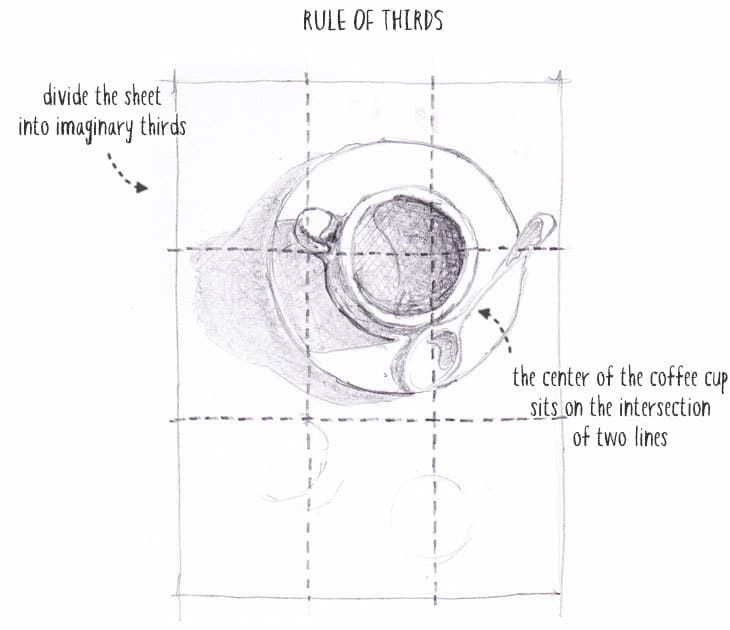
Remember, where you leave space around your subject is almost as important as the subject itself.
Style
I was aiming for a loose watercolor painting style for this painting. To achieve this I used various techniques to add drips, splatters, and movement within the watercolors.

Watercolors are a medium which lend themselves well to loose painting techniques. Personally, I also find this a good exercise for learning to “let go”, and not get too caught up in the details. That was one of my big problems when I started out as an artist.
Watercolor Coffee Cup Step by Step
I wasn’t sure that I got off to a good start with this painting. But I kept going and things seemed to work out better.
This is something we all face from time to time with a new painting. I had an image in my mind of what I wanted to paint but the first few brushstrokes went amiss! The most important lesson here is “don’t give up too soon”. Persistence usually pays off, even if you find your watercolors don’t look good in the early stages.
Below I’ll try to describe what’s happening as I progress through the painting. If you want to try this for yourself you can download the sketch template and transfer it to a sheet of watercolor paper (Click here to download).
(Oh… And yes… I am drinking coffee as I’m writing this !)
My approach was to work from the center of the painting outwards.

Step 1:
Begin by defining the cup in middle. To do this I used a watercolor technique known as wet on dry, but also some blending to smooth certain edges.
Different colors were laid on top of each other after the underlying paint was dry – in watercolors this produces an effect known as glazing.
By painting wet on dry (using a wet brush on dry paper) you can see that the shapes have sharp, well defined edges. This is true for most of the initial shape, with the exception of the upper lip where the color is blended, fading from a darker to a lighter hue.
To produce this blending effect you start by applying a brush stroke of strong color, then dip your brush in water, remove some of the excess moisture from the brush using a cloth or a sponge, then apply a new brush stroke to the edge of the first shape.
Repeat the process again, removing some more paint from your brush tip, then blotting the brush, before blending the shape some more.
By pulling the color outwards with the damp, diluted brush, you obtain a smooth gradient of color from dark to light.
The reason why you blot your brush to remove moisture is because you don’t want your new brush stroke to be wetter than the wash of color on the paper. Remember, water will move from wet to dry. If your new brushstroke is too wet it will flood the initial color with diluted paint and probably cause what’s known as a backwash or bloom.
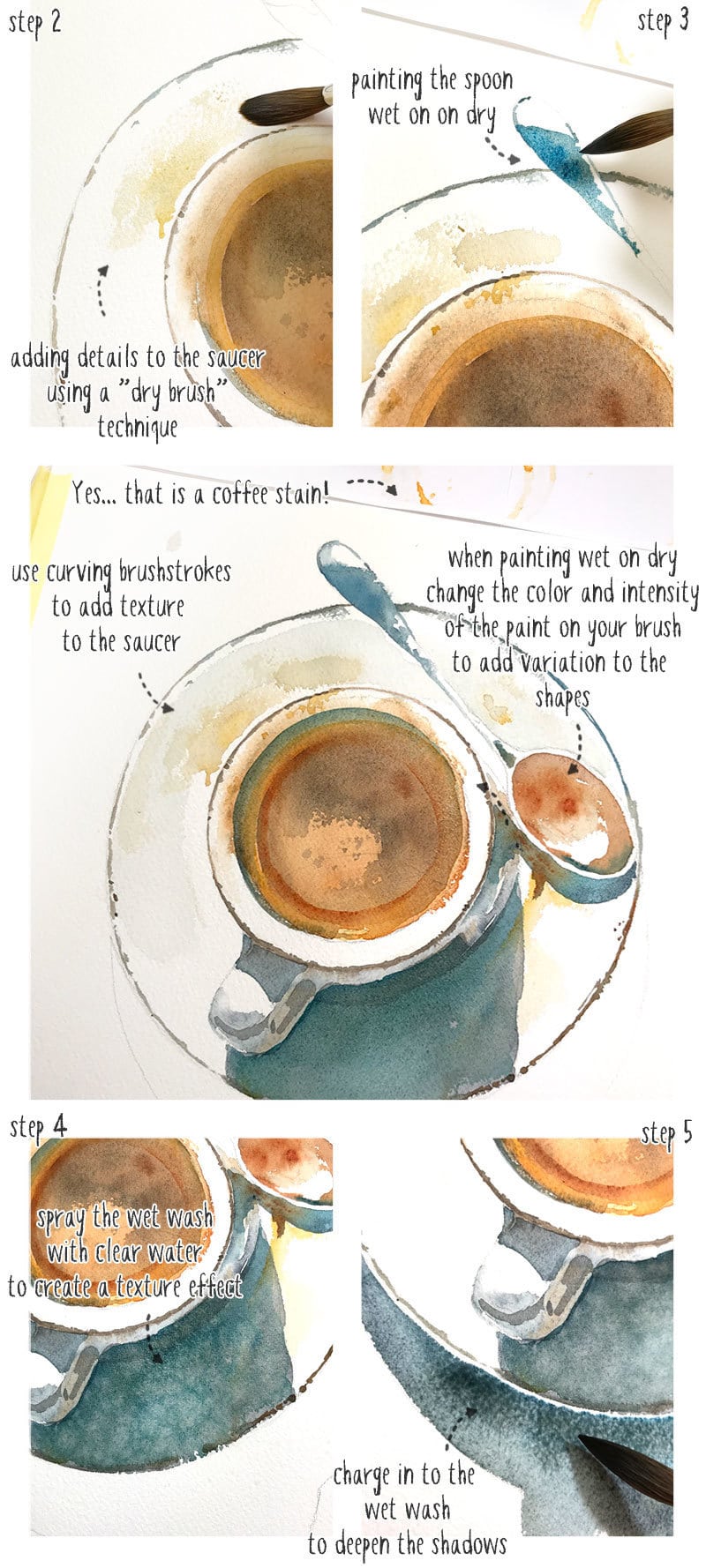
Step 2:
Now start adding some details to the saucer and spoon. Paint a thin dark edge to the saucer. You can see I’m adding a light color to the saucer using a drybrush technique. To do this you use a slightly damp brush and drag the side of the bristles across the paper. This gives a broken, textured brush stroke thanks to the bumpiness of the paper.
Step 3:
The rest of the spoon is painted with a wet on dry technique. When you paint like this, don’t hesitate to pick up different colors with your brush. They will mingle together on the paper when you paint into the moist shapes. This creates interesting changes in color and value.
Step 4:
Next I deepened the shadow of the cup with a new glaze of blue gray paint. For added texture I sprayed the still wet wash of the shadow with a spatter of water from a “spritzer” bottle. The droplets of clear water push the damp paint aside, creating light toned speckles.
Step 5:
The next step is to add the final shadows. I painted with a wet on dry technique and added deeper toned shadows to the edge of the saucer. To do this I just charge into the already wet wash of the shadow shape.
Charging in is a term in watercolor painting where you add more color to a damp wash. This is a way of mixing colors directly on the paper rather than in your palette. The colors will mix together smoothly and intensify the underlying wash.
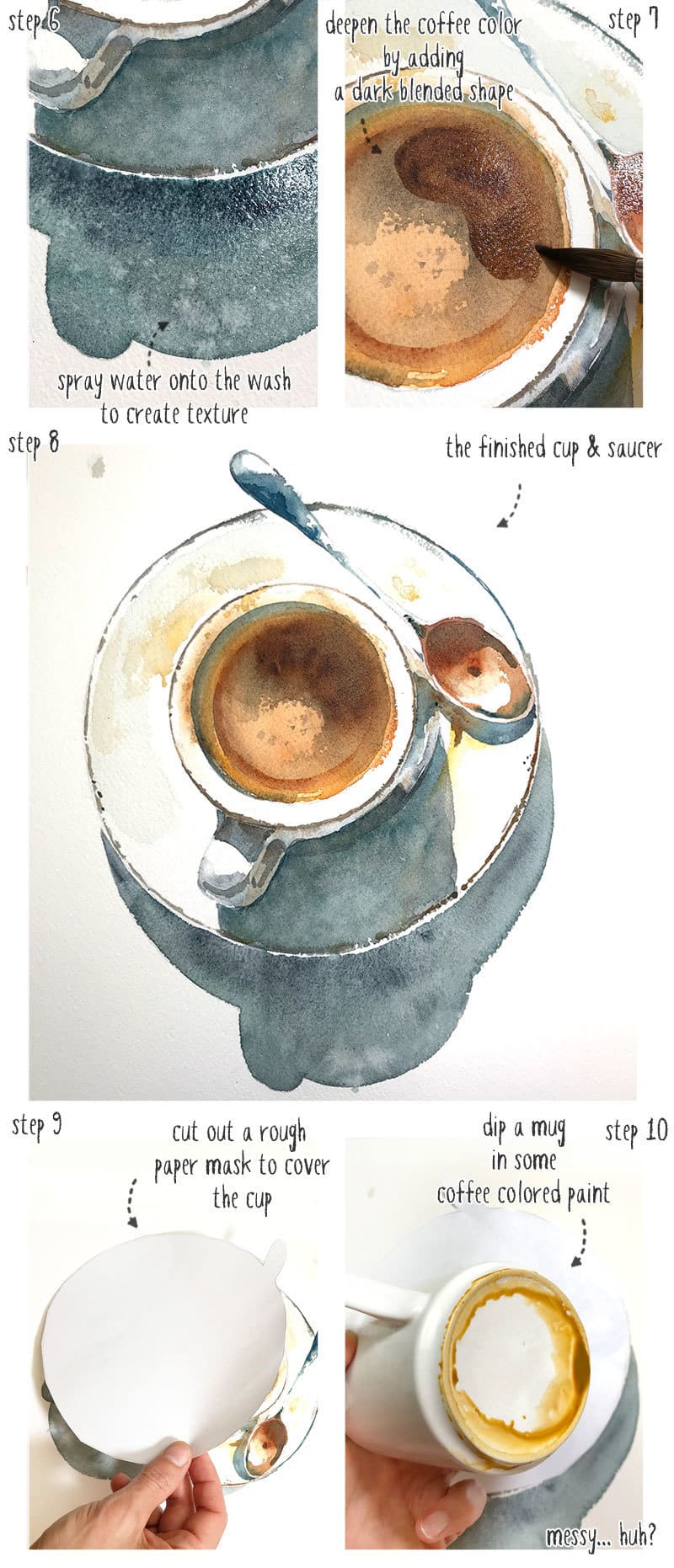
Step 6:
When the paint dries, add another glaze to the saucer shadows, then use a spray bottle again to add some texture with droplets of water.
Step 7:
At this stage I thought the coffee color needed deepening, so I added a dark shape of rich brown color (Burnt Umber). The edges of this shape were blended using the technique described above.
Step 8:
At this stage the cup and saucer are finished. But the fun isn’t over yet! In the next stages we’re working going to work on the background and add some liquid splatters and stains. This adds some visual interest to the overall painting.
Step 9:
To protect the finished cup from staining I made a quick paper cutout to cover it up. Don’t worry about making an accurate mask or using masking fluid. The loose nature of the painting means it doesn’t matter if some of the paint flows back onto the cup.
Step 10:
To imitate the ringed coffee stains I got an old mug and dipped the bottom in some coffee colored paint. Use the mug like an ink stamp to print ring stains onto the paper.
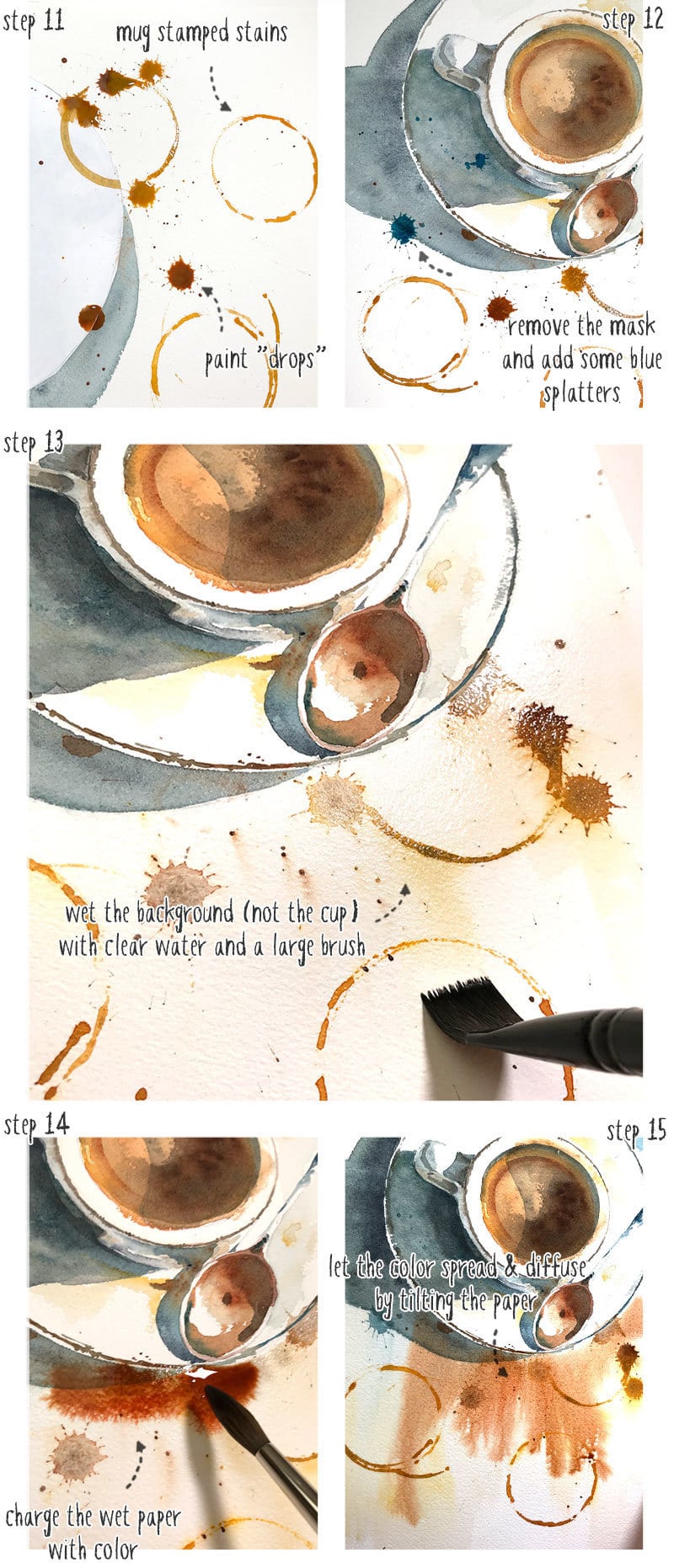
Step 11:
At the same time I added some drops of color. To do this, simply hold the brush vertically and squeeze the end of a soaked brush tip. This produces a nice round drop (as opposed to flicking the brush which produces directional splatters). The higher your brush relative to the page, the more it will explode on the paper.
Step 12:
Remove the paper mask from the cup and add some more drops and splatters, this time using a blue hue.
Step 13:
As a final touch for the background I used a wet on wet technique (wet brush onto wet paper) to add some diffused color. I started by brushing the background (not the cup shape) with clear water.
Don’t worry if this makes the other paint marks run. Simply use the brush to blend them using linear brushstrokes away from the cup.
Step 14:
Load your brush with plenty of watercolor and use a charging in technique to apply color to the edge of the saucer. The paint will start to diffuse into the wet paper.
Step 15:
Let the color run away from the cup by tilting the paper.
Step 16:
Use a large brush and clear water to even out the diffused paint as necessary. The result should be a range of light colored soft shapes over the background.
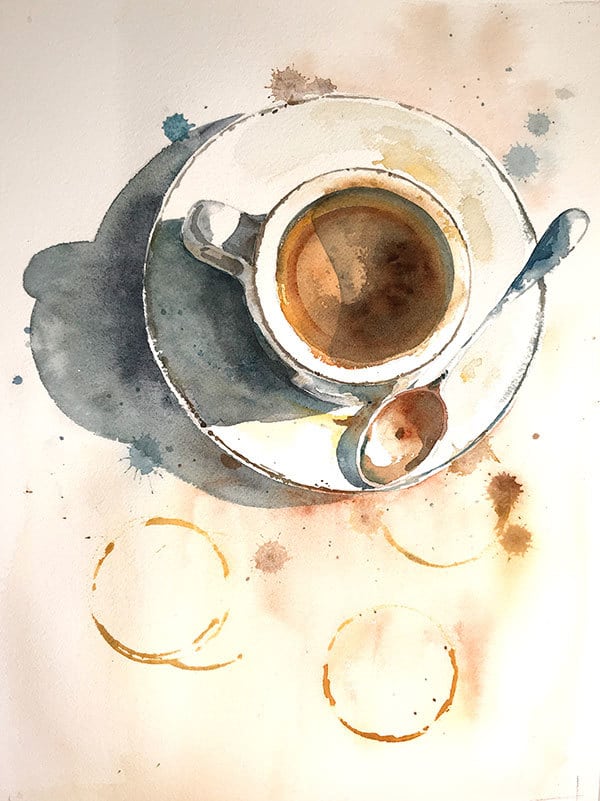
Hey presto ! (Or should that be “hey espresso” !)
Your coffee cup watercolor painting is now complete. Pat yourself on the back and go show off to your friends! (At least show it to your mum – she’s always your biggest fan).
Have fun…

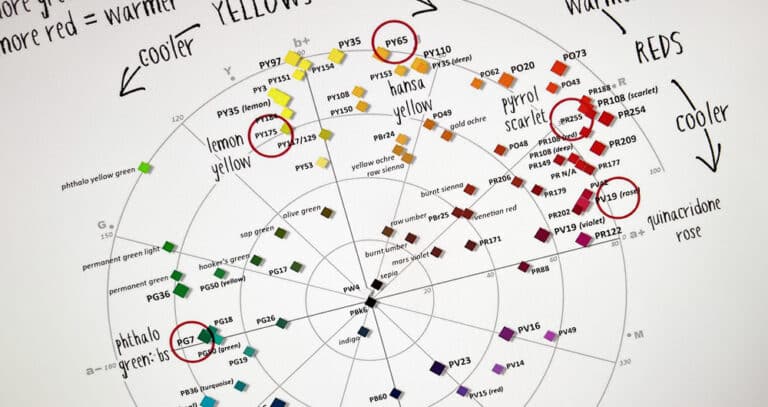


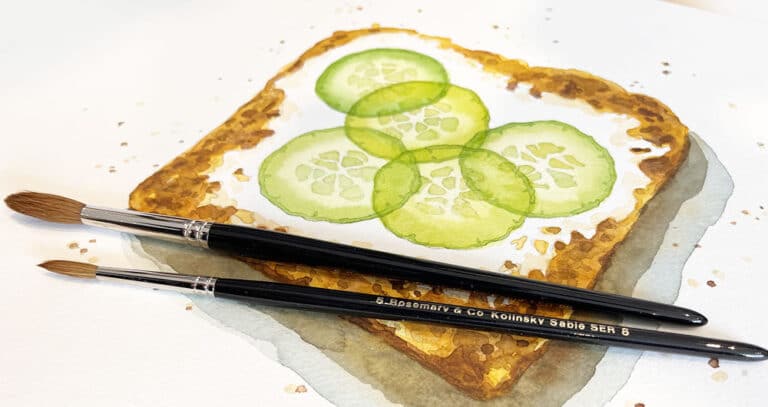

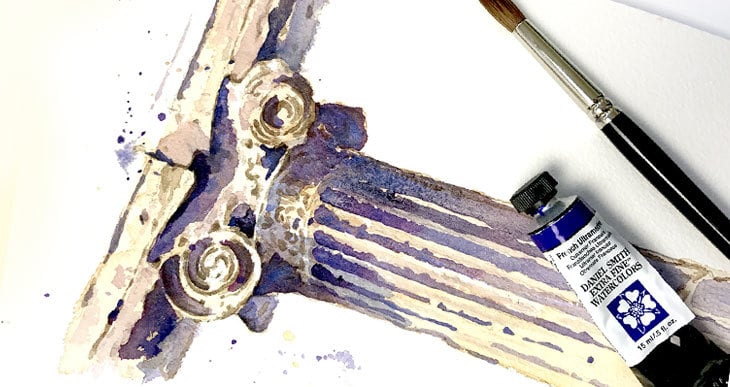
I did this painting from Helen Campbell on YouTube
Hi Monika
Yes, I guess coffee cups are a popular subject 🙂
Mine date’s back to September 2019. Helen’s YT video looks like it was published in 2020…
I loved this tutorial! I love how educational it is and how you explain the different techniques as you used them. I have used some of these In the past but I am so excited to know what they’re called! (Such as “charging”. Great job explaining all your different steps. Your tutorial inspires me to continue painting and to never stop learning and growing in art!
Glad to hear it Emma ! Keep on painting !
This is soo good, I love the way you teach and talk us through the finer details !! definitely a big FAN, thank you once again for the sketch too !!
Glad you’re enjoying the site Maithri !
Hello from Chile , to keep my mind away from the news ( All the news are about COVID 19 ) I start painting with watercolor and the beginning I felt frustrated but I found your website and I couldn’t believe my eyes when I finished this marvelous tutorial !! I did it !! Thank you for this master class .
I would like to thank you for that amazing tutorial! I had a really fun afternoon, painting this cup of coffe:):):)
Thanks Ewa – really good to know you’re enjoying your watercolors !
Thank you Anthony, I just came across this site. I am new to watercolors,I started to keep myself busy (and sane) during COVID. I really enjoy sketching (w/pencil) and love using the watercolors, but find I try to make it “perfect” and wind up overworking. Would love to loosen up a bit (or a lot:)), just not sure where to start. Will continue following your advice, reading more and of course, practicing more! Thank you for your helpful and interesting way of sharing your gift!
Glad you’re finding the site useful Peggy – enjoy your painting !
Hi, Anthony,
I just tuned in to your site yesterday, looking for tips on helping my niece, who is brand new to watercolors, set up her initial palette (without breaking the bank). I read your article on choosing and setting up a palette, and then moved on to this tutorial, as well as the one describing your approach to a winter painting of a little boy reaching for a snowflake. I find your teaching method clear and effective, as well as warm, humorous, and friendly. In other words, helpful and delightful. Just right. I look forward to visiting you in the future! Thank you for your highly educational lessons!
Thanks for your kind words Marie !
I loved this lesson, as I love them ALL! Keep them coming PLEASE!!!!
Thanks! My granddaughter is a coffee hound, and I am new to watercolor. I found you on Pinterest, and this might be her Christmas card!
Good idea Bonnie !
Thanks so much for sharing this coffee painting post! I followed it and made it for my son for Christmas gift. I am new to painting and I’m loving it thank you!
Great news Debbie – I’m sure he will love it!
Loved this. I’ve done it once as a study of techniques, but am going to do it again for pleasure. I appreciate the line drawing – I’d waste most of a day just trying to draw one. Please keep these exercises a’comin!
I love your tutorials as well as your artwork! This coffee painting is so good and very clever.
Thank you!